An Annotated Checklist of Cyperceae, Eriocaulaceae and Potamogetonaceae of Chhattisgarh
0 Views
A.K. VERMA, O.N MAURYA, SANJAY MISHR AAND KUMAR AVINASH BHARATI
Department of Botany, Siddharth University, Kapilvastu, Siddharth Nagar-272202.
ABSTRACT
Tropical forests of Chhattisgarh are known for rich floristic diversity and many important protected forests of central India. An updated annotated checklist is provided for the family Cyperaceae, Eriocaulaceae, and Potamogetonaceae of Chhattisgarh It has breen prepared with the help of herbarium specimens housed in BSA and relevant literatures pertaining to the floristic diversity of the state. A total of 118 taxa (species, subspecies and varieties), representing 15 genera under 3 families are provided in the present communication. Family Cyperaceae has 104 taxa, Eriocaulaceae has 13 taxa and Potamogetonaceae has 5 taxa. At generic level remarkable diversity has been recorded in Cyperus (37 species and one variety) and Fimbristylis (21 species and one subspecies). The distribution of taxa is highest in Raipur (75 taxa), followed by Bilaspur (70 taxa), Bastar (64 taxa), Surguja (48 taxa), Raigarh (47 taxa), Dantewada (44 taxa), etc.
KEYWORDS: Angiosperm; Monocotyledons; Flora; Diversity; Ecosystem.
INTRODUCTION
Chhattisgarh is a state in central India with an area of 1,35,194 sq. km. The state was created on 1st November 2000 from Madhya Pradesh; it is 9th largest state by area and 7th most populous state of the India. Chhattisgarh shares boarder with Uttar Pradesh in north, Madhya Pradesh in northwest, Maharashtra in southwest, Jharkhand in northeast, Odisha to east, Andhra Pradesh and Telangana in south. It has diverse geography, ranging from hilly terrains to plains with variation in climatic condition. Most of the southern and northern part has hilly terrain and central part is fertile plain. The state has the 3rd largest forest by area in India with many national parks and Achanakmar-Amarkantak Biosphere Reserve.
Forest cover of Chhattisgarh is 46% of its total area; it is dominated by Shorea robusta and Tectona grandis. According to Champion and Seth (1968) forests of Chhattisgarh may be classified into 3 types: (1) Tropical moist deciduous, (2) Tropical dry deciduous, (3) Montane subtropical. The tropical moist deciduous forest is dominated by mainly deciduous species, subdominant and lower storey are mostly evergreen. Top canopy is not very dense with abundance of climbers and epiphytes. Tectona grandis, Terminalis alata, Haldiana cordifolia, Pterocarpus marsupium, Gmelina arborea, Terminalia chebula, Anogeissus latifolia, Mitragyna parvifolia, Bridelia retusa, Syzygium cumini, etc. are top canopy species.
The second storey is comprises of Grewia tiliifolia, Mallotus philippensis, Cleistanthus Collins, Semecarpus anacardium, Kydia calycina, Kydia calycina, Bauhinia malabarica, Wendlandia heynei, Syzgium cumini, Millusa tomentosa, Dillenia pentagyna. Third storey consists of Ixora arborea, Helicteres isora, Petalidium barlerioides, Grewia hirsute, Woodfordia fruiticosa, Clerodendrum serratum, Phoenix acaulis, Eranthemum purpurascens, Andrographis paniculata, etc. Common climbers are Bauhinia vahlii, Ichnocarpus frutescens, Erycibe paniculata, Smilax zeylanica, Millettia extensa, Combretum roxburghii, Dioscorea hispida, etc. Forth storey is found in moist mixed deciduous forest mainly consist of Blepharis maderaspatensis, Desmodium pulchellum, Arvea lanata, Indigofera linnaei, etc.
Tropicaldrydeciduousforestismixedwithdeciduous trees like, Shorea robusta, Terminalia alata, Terminalia bellirica, Buchanania lanzan, Diospyrous melanoxylon, Mallotus philippensis, Ptercarpus marsupium, Accacia catechu, Lannea coromandelica, Boswellia serrata, Anogeissus latifolia, Butea monosperma, Sterculia urens, Lagerstroemia parviflora, Aegel marmelos, In third storey Indigofera cassioides, Woodfordia storey fruticosa, Flemingia semialata, Ixora arborea, etc. are with frequently found. Second storey consists of Gardenia turgida, Flacourtia indica, Balanites aegyptiaca, Ziziphus xylopyra, etc. Butea superba, Bauhinia vahlii, Cansjera rheedii, Calycopteris floribunda, Cryptolepis buchanani, Cocculus hirsulus, Tinospora cordifolia, Ventilago denticulate, etc. are common climbers.
Table 1: Enumeration of the taxa of the family cyperaceae , Eriocaulaceae and potamogetonaceae

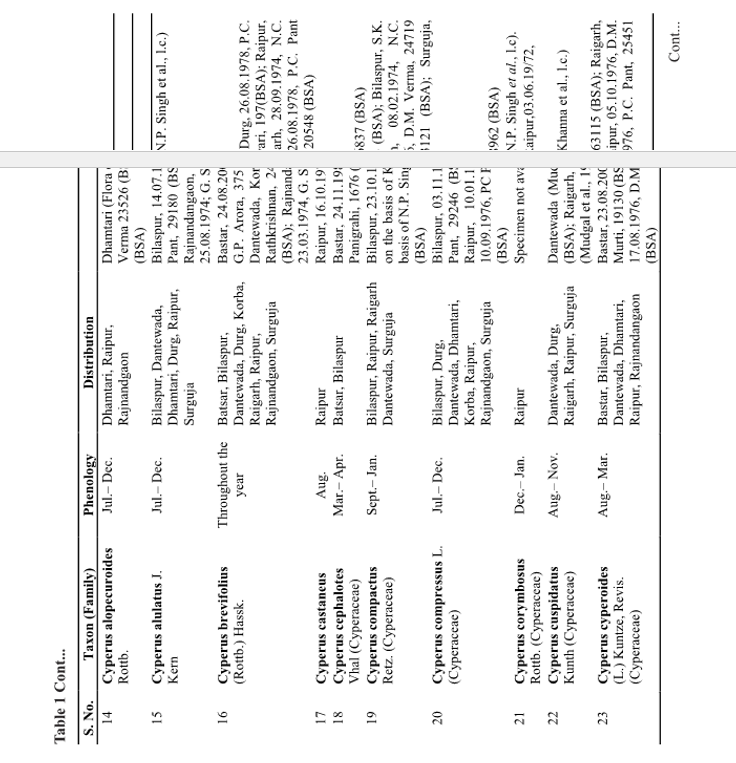
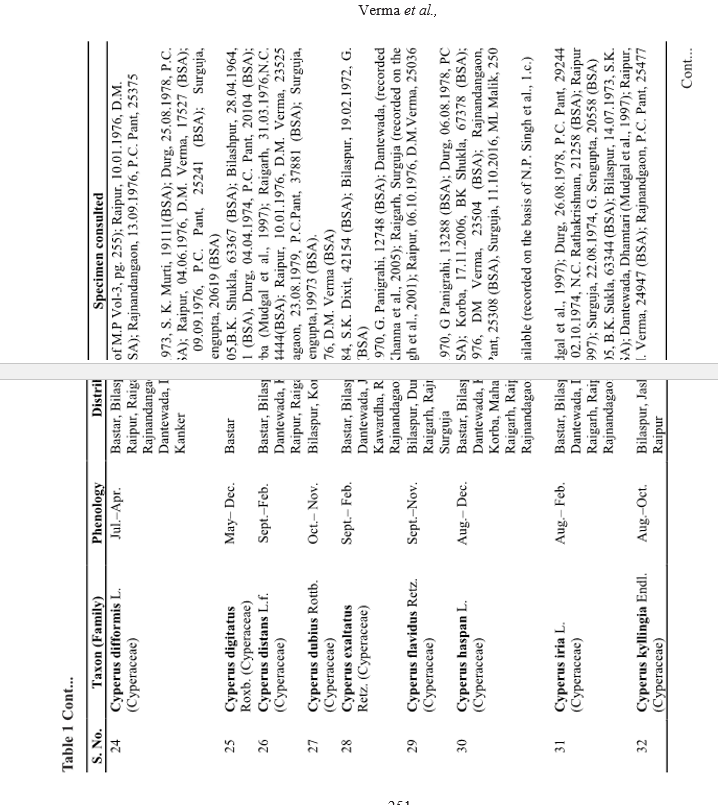
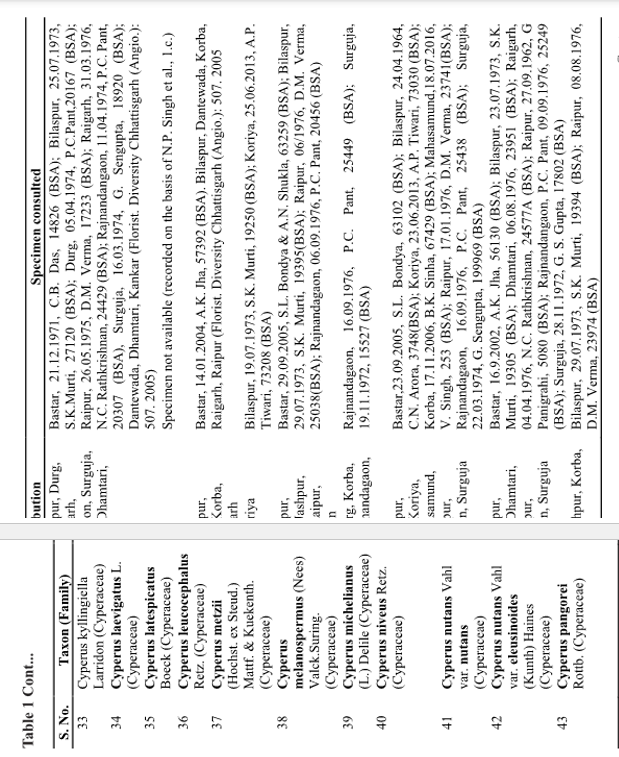
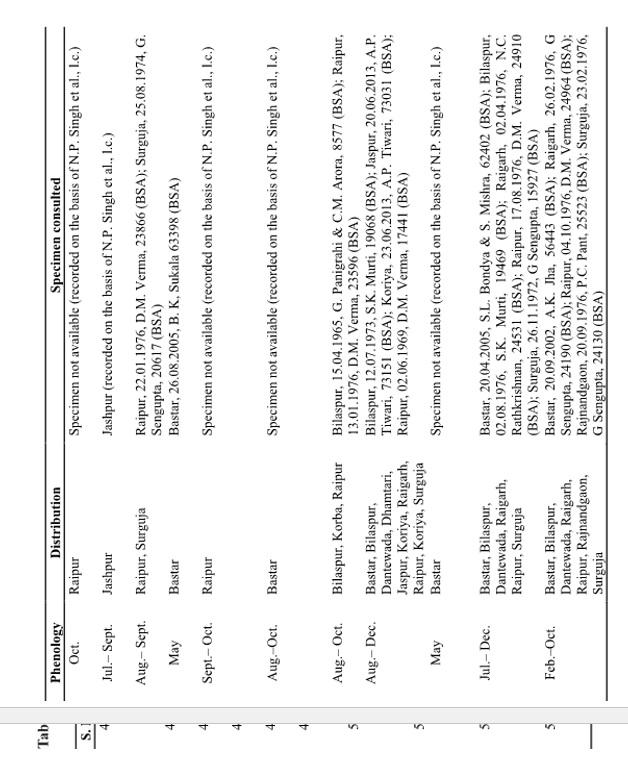
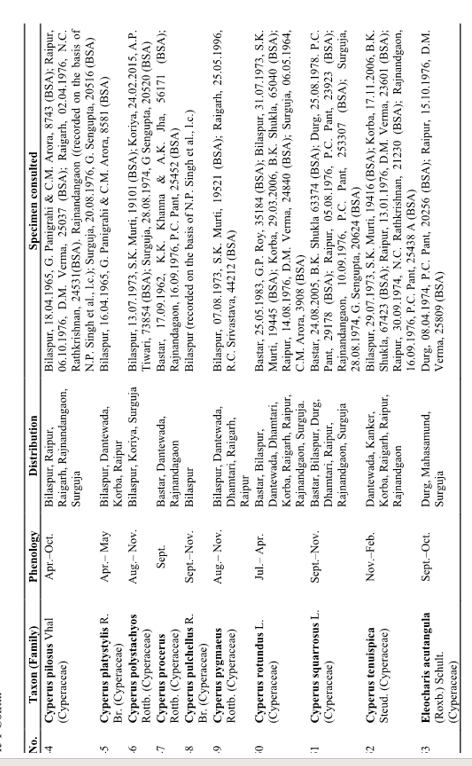
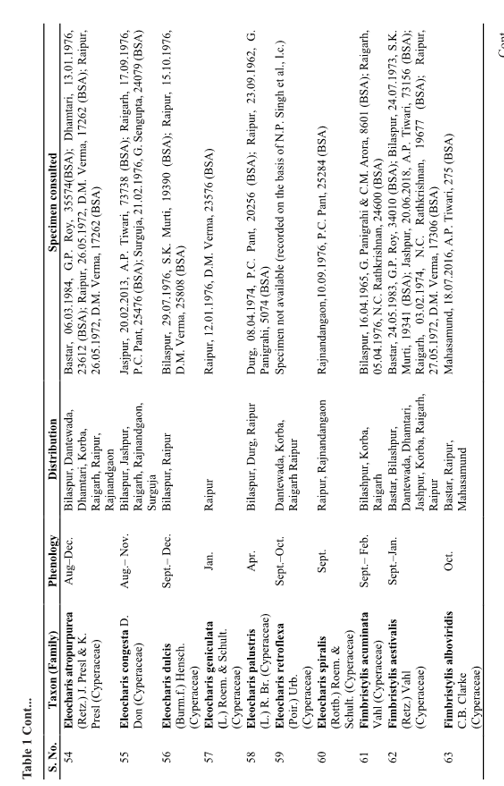
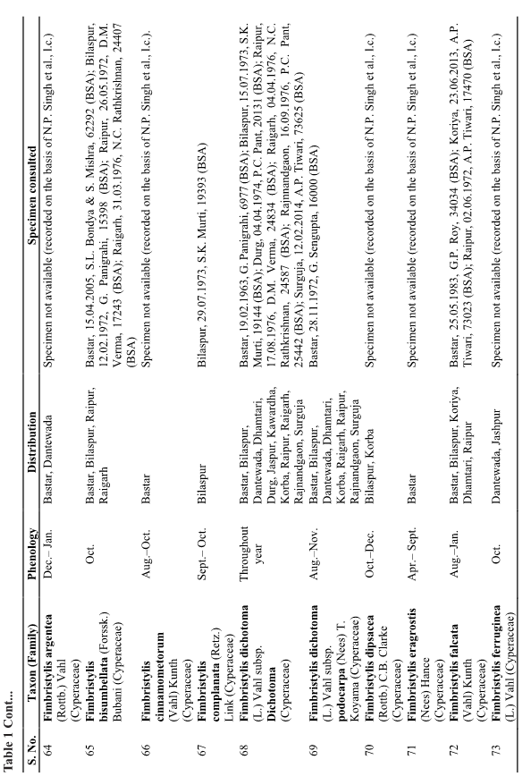


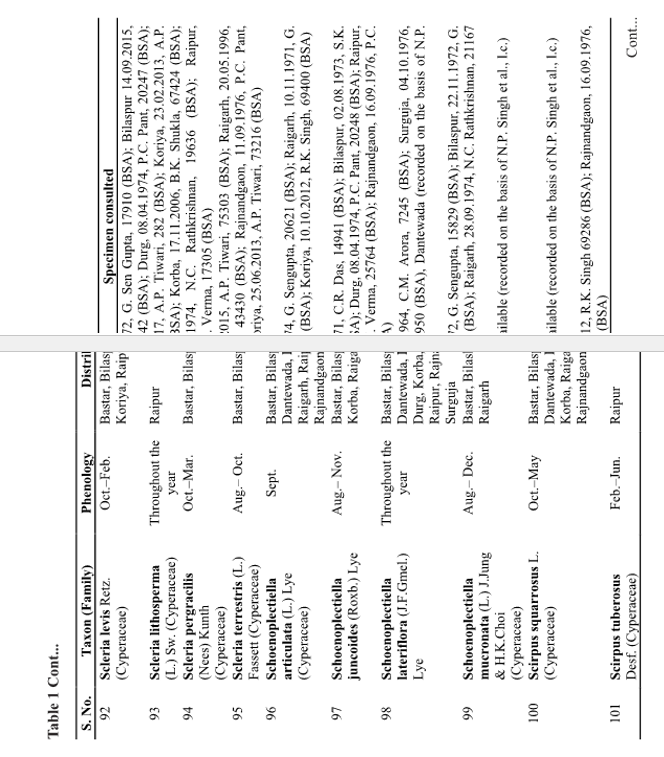
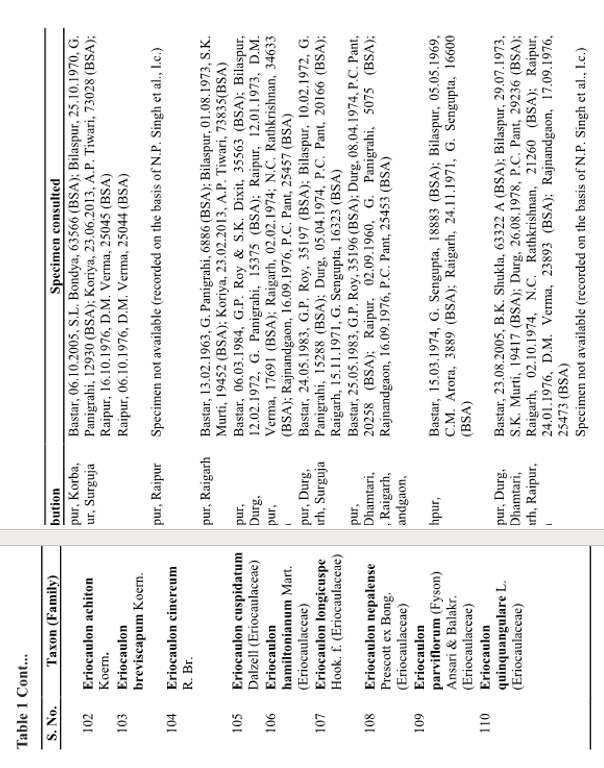

Montane subtropical forests are confined to Bastar and Bilaspur area on hilly tracts. These are dense forests andcomposedofevergreenelements.Topcanopyconsists of Canthium dicoccum, Celtis cinnamomea, Chionanthus ramiflorus, Syzygium cumini, S. nervosum, Wendlandis heynei,etc.SecondstoreycomponentsareSymplocos lauria,
racemosa, Glochidion multiloculare, grewia tiliifolia, mallotus philippensis, Memecylon umbellatum, etc. In third storey Melastoma malabathricum, Rhinacanthus nasuta, Pogostemon benghalense, etc. are mainly found. Noticeable climbers in this type of vegetation are Cansjera rheedii, Calycopteris floribunda, Symphorema polyandrum, Smilax zeylanica, Clematis smilacifolia, etc.
After review of the past publications on the diversity o fangiosper mo fChhattisgar hviz .b yWoo d(1902) ,Hains (1916), Narayanaswami and Mooney (1941), Mooney (1942), Raizada (1947), Tiwari (1957, 1963), Tiwari and Maheshwari (1963, 1965), Unni (1967b), Subramanyam and Henry (1967), Arora (1968), Champion and Seth (1968), Saxena (1973), Saxena and Khotele (1976), Verma and Chandra (1981), Verma et al. (1985), Roy and Chaturvedi (1987), Panigrahi and Murthi (1989), Dixit and Roy (1992a), Dixit and Roy (1992b), Verma, et al. (1993), Kumar (1993, 1995, 1998), Mudgal et al. (1997),
Murthi and Panigrahi (1999), Khanna et al. (2001), Singh et al. (2001), Jha and Khanna (2002a), Jha and Khanna (2003). it was concluded that the updated checklist of the Cyperaceae, Eriocaulaceae and Potamogetonaceae is not available; therefore, present work has been taken up with the objective of studying the diversity in family Cyperaceae, Eriocaulaceae and Potamogetonaceae in Chhattisgarh .
MATERIAL AND METHODS
The data has been collected from the herbarium specimens preserved at herbarium of Central Regional Circle, Botanical Survey of India, Allahabad (BSA) and relevant literatures published on Chhattisgarh (Miudgal et al., 1997; Singh et al., 2001; Khanna et al., 2005). In present treatment, list of herbarium under above mention family have been shorted and list of taxon with collection data have been noted down. After verification of the species with relevant literatures, left-out species were added to the list. Information given on annotation slips was considered and details of the consulted specimens have been compiled with the associated taxa. Further, phenological information and distribution at district level have been compiled from herbarium (BSA) and literatures. Nomenclatures of the taxa has been updated with help of International Plant Names Index (IPNI) https://www.ipni.org/ and Plants of the World Online (POWO) https://powo.science.kew.org/.
RESULTS AND DISCUSSION
A total of 118 taxa have been enumerated in present communication (Table 1). In family Cyperaceae, a total of 102 species, one subspecies (Fimbristylis dicotoma subsp. podocarpa) and one variety (Cyperus. nutans var. elensinoides) have been documented. Family Cyperaceae is represented by 12 genera and the maximum representation is by genera Cyperus (37 species and one variety), followed by Fimbristylis (21 species and one subspecies), Scirpus (9 species), Carex and Eleocharis (8 species), Scleria (6 species), etc. (Fig. 1). Family Potamogetonaceae has two genera Potamogeton (4 species) and Stuckenia (1 species). Family Eriocaulaceae is represented by one genus Eriocaulon having 13 species.
Out of 33 districts, distribution of taxa in 17 districts have been recorded maximum number of taxa has been documented Raipur (75 taxa), Bilaspur (70 taxa), Bastar (64 taxa), Surguja (48 taxa), Raigarh (47 taxa), Dantewada (44 taxa), Korba (32 taxa), Dhamtari and Rajnandgaon (25 taxa each), Durg (20 taxa), Koriya (12 taxa), Jashpur (8 taxa), Kanker and Mahasamund (4 taxa each), Jaspur (3 taxa), Kawardha (2 taxa) and Bijapur (1 taxa) (Fig. 2). The distribution in the old districts is recorded because herbarium specimens are collected before creation of new districts. Observation of phenology shows that flowering and fruiting time of four species (Cyperus brevifolious, Fimbristylis dicotoma, Scleria lithosperma and Scirpus lateriflorus) are throughout the year, three species have 10 months of flowering and fruiting time (Cyperus difformis, Cyperus rotundus, Fimbristylis ovata) and 19 species has only one month of flowering and fruiting time. Fig. 3 shows that out of 118 taxa, 72 taxa have reproductive phase in month of October, 70 taxa have reproductive phase in month of September, 59 taxa have reproductive phase in month of November, 44 taxa have reproductive phase in month of December, 42 taxa have reproductive phase in month of August, etc.
Distributions of taxa were documented on the basis of herbarium collection data and authentic literatures. The herbarium collection data of 78 taxa were available and distribution records of rest of the 24 taxa were taken from authentic literatures (Khanna et al., 2005).
LITERATURE CITED
Arora, C.M. 1968. The Botany of Bailadilla, Bastar State, M.P. Bull. Bot. Surv. India 10: 61-66.
Murthi, S.K. and Panigrahi, G. 1999. Flora of Bilaspur District (Madhya Pradesh) – Vol. 2. Flora of India- Series 3. Botanical Survey of India, Calcutta.
Champion, H.G and Seth, S.K. 1968. A revised survey of the forest types of india. Manager of Publications, Delhi.
Dixit, S.K and Roy, G.P. 1992a. Recollection of some little known taxa from Bastar district, Madhya Pradesh. Journal of Economic and Taxonomic Botany. 16(1): 185-192.
Dixit, S.K and Roy, G.P. 1992b. Additions to the flora of Bastar District, Madhya Pradesh. Journal of Economic and Taxonomic Botany. 16(2): 351-365.
Jha, Ajay Kumar and Khanna, K.K. 2002a. Preliminary studies on the floristic diversity (Angiosperms) of Bastar, Chhattisgarh. Proc. 89th Indian Sci. Congress, Part III. 26-27.
Jha, Ajay Kumar and Khanna, K.K. 2003. Status of floristic studies in Bastar district, Chhattisgarh. Proc. 90th Indian Sci. Congress, Part III. 1-2.
Khanna, K.K. 2005. Floristic Diversity of Chattisgarh. Bishen Singh Mahendra Pal Singh, Dehra Dun- 248001.
Khanna, K.K., Kumar Anand, Dixit, R.D and Singh, N.P. 2001. Supplement to the flora of Madhya Pradesh. Botanical Survey of India, Calcutta.
Kumar Anand. 1993. New distributional records of some angiosperms from Madhya Pradesh. Journal of Economic and Taxonomic Botany. 17: 143-145.
Kumar Anand. 1998. Contribution to the flora of the Indravati Tiger Reserve, Bastar (Madhya Pradesh). Journal of Economic and Taxonomic Botany. 22: 287-320.
Kumar Anand. 1995. Contribution to the rare flowering plants of the Indravati Tiger Reserve, Bastar (Madhya Pradesh). Journal of Economic and Taxonomic Botany. 19: 411-418.
Kumar Anand. Family Opiliaceae in Madhya Pradesh.
Journal of Economic and Taxonomic Botany. 12: 430-432. 1988.
Mooney, H.F. 1942. A sketch of the flora of Bailadilla Range in Bastar State. Indian For. Rec. (n.s.) 3(7): 197-253.
Mudgal, V., Khanna, K.K and Hajra, P.K. 1997. Flora of Madhya Pradesh Vol. II. Botanical Survey of India, Calcutta
Murthi, S.K. and Panigrahi, G. 1999. Flora of Bilaspur District (Madhya Pradesh) – Vol. 2. Flora of India- Series 3. Botanical Survey of India, Calcutta.
Panigrahi, G. and Murthi, S.K. 1989. Flora of Bilaspur District (Madhya Pradesh) – Vol. 1. Flora of India-
Series 3. Botanical Survey of India, Calcutta.
Roy, G.P. and Chaturvedi, K.K. 1987. Less known medicinal uses of rare and endangered plants of Abujhmarh reserve area, Bastar (M.P.). J. Econ. Tax. Bot. 9: 325-328.
Saxena, H.O. and Khotele, S.N. 1976. A contribution to the flora of Bastar (M.P.). J. Bombay Nat. Hist. Soc. 73: 21-34.
Saxena, H.O. 1973. Further contribution to the flora of Bailadilla (M.P.). J. Bombay Nat. Hist. Soc. 70: 586-590.
Singh, N.P., Khanna, K.K., Mudgal, V. and Dixit, R.D. 2001. Flora of Madhya Pradesh Vol. III. Botanical Survey of India, Calcutta.
Subramanyam, K. and Henry, A.N. 1967. Vascular plants of Bastar, M.P. Bull. Bot. Surv. India 8: 207-215.
Tiwari, S.D.N. 1963. Supplement to the grasses of Madhya Pradesh. Indian For. 89: 593-612.
Tiwari, S.D.N. and Maheshwari, J.K. 1963. Orchids of Madhya Pradesh. Indian For. 89: 426-444.
Tiwari,S.D. NandMaheshwari,J.K.1965 .Commelinaceae of Madhya Pradesh. Indian For. 91: 580-590.
Tiwari, S.D.N. 1957. Grasses of Madhya Pradesh. Indian For. 80: 601-611, 681-689. 1954; 81: 107-115.
1955; 83: 191-200.
Unni, K.S. 1967b. Compositae of Raipur and its surroundings. J. Bombay Nat. Hist. Soc. 64: 333- 338.
Verma, D.M. and Chandra, V. 1981. Cyperaceae of Madhya Pradesh. Rec. Bot. Surv. India 21: 221-275.
Verma, D.M., Balakrishnan, N.P. and Dixit, R.D. 1993. Flora of Madhya Pradesh Vol. I. Botanical Survey of India, Calcutta.
Verma, D.M., Pant, P.C. and Hanfi, M.I. 1985. Flora of Raipur, Durg and Rajnandgaon. Flora of India- Series 3. Botanical Survey of India, Howrah.
Wood, J.J. 1902. Plants of Chhota Nagpur, including Jashpur and Surguja. Rec. Bot. Surv. India 2(1): 1-170.
- Production Potential of Sweet Corn as Influenced by Organic Manures and Foliar Nutrition
- Characterization of Grain Iron and Zinc Content in Little Millet Genotypes
- Faunistic Studies on Economically Important Lepidopterans in Different Field Crops of Tirupati District
- An Annotated Checklist of Cyperceae, Eriocaulaceae and Potamogetonaceae of Chhattisgarh
- Genetic Divergence Studies for Yield, Yield Components and Resistance to Late Leaf Spot in Groundnut (Arachis Hypogaea L.)
- Effect of Organic Farming on Soil Enzymatic Activity and Productivity of Groundnut Based Cropping System

